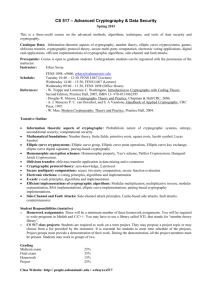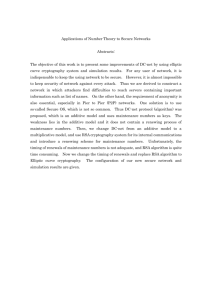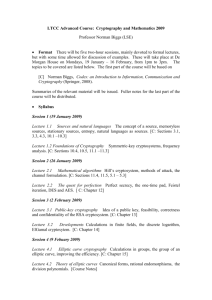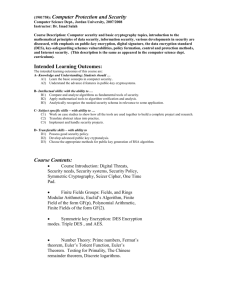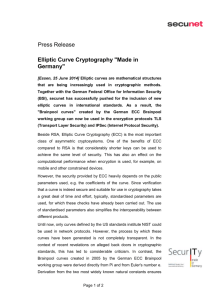Lecture 13
advertisement
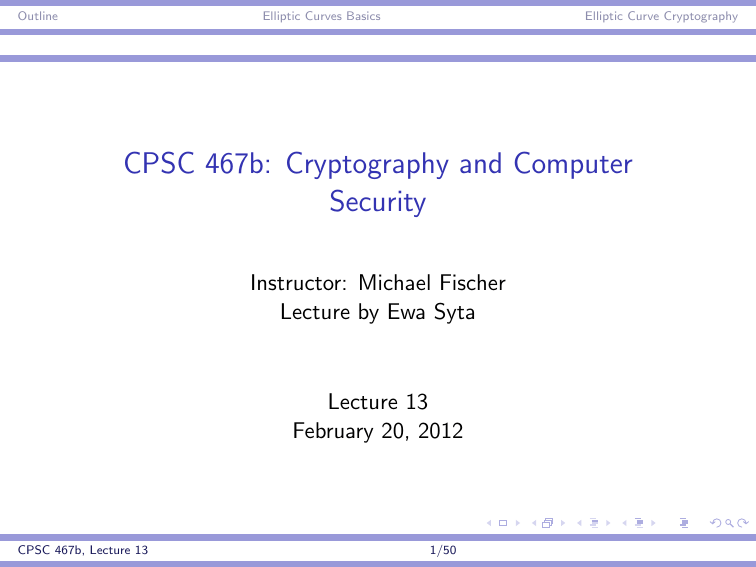
Outline
Elliptic Curves Basics
Elliptic Curve Cryptography
CPSC 467b: Cryptography and Computer
Security
Instructor: Michael Fischer
Lecture by Ewa Syta
Lecture 13
February 20, 2012
CPSC 467b, Lecture 13
1/50
Outline
Elliptic Curves Basics
Elliptic Curve Cryptography
Elliptic Curves Basics
Elliptic Curve Cryptography
CPSC 467b, Lecture 13
2/50
Outline
Elliptic Curves Basics
Elliptic Curve Cryptography
Elliptic Curves Basics
CPSC 467b, Lecture 13
3/50
Outline
Elliptic Curves Basics
Elliptic Curve Cryptography
Elliptic Curves
An elliptic curve E over a field K is a set of points (x, y ) with
x, y ∈ K , together with a special point O called the point at
infinity. The (x, y ) points are the roots of a Weierstrauss equation
of the form:
E : y 2 + a1 xy + a3 y = x 3 + a2 x 2 + a4 x + a6 ,
where the polynomial on the right hand side has no double roots.
For particular fields K , the Weierstrauss equation takes a simpler
form, as we shall see.
CPSC 467b, Lecture 13
4/50
Outline
Elliptic Curves Basics
Elliptic Curve Cryptography
EC over Real Numbers
Definition (6.3 of Stinson)
Let a, b ∈ R be constants such that 4a3 + 27b 2 6= 0.
A non-singular elliptic curve is the set E of solutions
(x, y ) ∈ R × R to the equation
y 2 = x 3 + ax + b
together with a special point O called the point at infinity.
The point at infinity is sometimes denoted by ∞.
CPSC 467b, Lecture 13
5/50
Outline
Elliptic Curves Basics
Elliptic Curve Cryptography
EC over Real Numbers
The condition 4a3 + 27b 2 6= 0 is necessary and sufficient to ensure
that the elliptic curve equation has three distinct roots.
If 4a3 + 27b 2 = 0, then corresponding elliptic curve is called a
singular elliptic curve.
Singular elliptic curves are not safe for cryptographic uses.
CPSC 467b, Lecture 13
6/50
Outline
Elliptic Curves Basics
Elliptic Curve Cryptography
Example
Each choice of the numbers yields a different elliptic curve.
Image retrieved from http://en.wikipedia.org/wiki/Elliptic_curve
CPSC 467b, Lecture 13
7/50
Outline
Elliptic Curves Basics
Elliptic Curve Cryptography
EC Operations
Exactly one of these conditions holds for any pair of points on an
elliptic curve.
Image retrieved from http://en.wikipedia.org/wiki/Elliptic_curve
CPSC 467b, Lecture 13
8/50
Outline
Elliptic Curves Basics
Elliptic Curve Cryptography
EC Modulo a Prime
Elliptic curves over Zp are defined exactly as they are over real
numbers.
Definition (6.4 of Stinson)
Let p > 3 be a prime. The elliptic curve y 2 = x 3 + ax + b over Zp
is the set of solutions (x, y ) ∈ Zp × Zp to the congruence
y 2 ≡ x 3 + ax + b mod p
where a, b ∈ Zp are constants such that 4a3 + 27b 2 6= 0, together
with a special point O called the point at infinity.
CPSC 467b, Lecture 13
9/50
Outline
Elliptic Curves Basics
Elliptic Curve Cryptography
Example
E : y 2 = x 3 − x over finite field F61
Image retrieved from http://en.wikipedia.org/wiki/Elliptic_curve
CPSC 467b, Lecture 13
10/50
Outline
Elliptic Curves Basics
Elliptic Curve Cryptography
Example
Elliptic curves mod p are finite sets of points. These are the elliptic
curves we are interested in.
E : y 2 ≡ x 3 + 4x + 4 mod 5 creates the following group:
(0, 2), (0, 3), (1, 2), (1, 3), (2, 0)(4, 2), (4, 3), O
To find the points, substitute each possible value of
x = {0, 1, 2, 3, 4} into the equation and find the values of y that
solve the equations.
For example,
x ≡ 0 ⇒ y 2 ≡ 4 ⇒ y ≡ 2, 3 mod 5
which gives us two points (0, 2) and (0, 3).
CPSC 467b, Lecture 13
11/50
Outline
Elliptic Curves Basics
Elliptic Curve Cryptography
Number of Points on a Curve
Theorem (Hasse’s Theorem)
Suppose E mod p has N points. Then
√
|N − p − 1| < 2 p.
Hasse’s theorem bounds the number of points on an elliptic curve
over a finite field.
√
√
#E (Fp ) lies in the interval (p + 1 − 2 p, p + 1 + 2 p).
CPSC 467b, Lecture 13
12/50
Outline
Elliptic Curves Basics
Elliptic Curve Cryptography
Adding Points
All arithmetic operations are performed in Zp .
Unfortunately, the addition of points on an elliptic curve over Zp
does not have the nice geometric interpretation that it does on an
elliptic curve over R.
CPSC 467b, Lecture 13
13/50
Outline
Elliptic Curves Basics
Elliptic Curve Cryptography
Adding Points
Let P = (xP , yP ), Q = (xQ , yQ ) and R = (xR , yR ) be points on E .
1. Add the point at infinity to itself.
O+O =O
2. Add the point at infinity to any other point.
P +O =O+P =P
3. Add two points with the same x-coordinates and different (or
equal to 0) y -coordinates: xQ = xP and yQ = −yP .
P +Q =O
CPSC 467b, Lecture 13
14/50
Outline
Elliptic Curves Basics
Elliptic Curve Cryptography
Adding Points
4. Add two points with different x-coordinates.
P +Q =R
xR = λ2 − xP − xQ , yR = λ(xP − xR ) − yP
λ = (yQ − yP )(xQ − xP )−1
5. Add a point to itself (point doubling).
P +P =R
xR = λ2 − 2xP , yR = λ(xP − xR ) − yP
λ = (3xP2 + a)(2yP )−1
CPSC 467b, Lecture 13
15/50
Outline
Elliptic Curves Basics
Elliptic Curve Cryptography
Why adding points works? (6.5.1 of Stinson)
The algebraic formula follows the geometric addition. Here it how
it works.
To add two points, P and Q, we define L to be the line through P
and Q. The line L will intersect E in one further point R 0 . If we
reflect R 0 in the x-axis, then we get a point which we name R.
The equation of L is is y = λx + ν, where the slope of L is
λ=
yQ − yP
xQ − xP
and
ν = yP − λxP = yQ − λxQ
CPSC 467b, Lecture 13
16/50
Outline
Elliptic Curves Basics
Elliptic Curve Cryptography
Why adding points works?
In order to find the points E ∩ L, we substitute y = λx + ν into
the equation E , obtaining the following:
(λx + ν)2 = x 3 + ax + b
which is the same as
x 3 − λ2 x 2 + (a − 2λν)x + b − ν 2 = 0
E ∩ L consists of three points, two of which we already know: P
and Q. The roots of the above equation are the x-coordinates of
the points in E ∩ L, hence, xP and xQ are the two roots.
CPSC 467b, Lecture 13
17/50
Outline
Elliptic Curves Basics
Elliptic Curve Cryptography
Why adding points works?
Since the equation is cubic, there are three roots. The sum of
three roots must be the negative of the coefficient of the quadratic
term, or λ2 . Therefore:
xR 0 = λ2 − xP − xR
where xR 0 is the x-coordinate of the point R 0 . We will denote the
y -coordinate of R 0 by −yR , so the y -coordinate of R will be yR .
An easy way to compute yR is to use the fact that the slope of L,
namely λ is determined by any two points on L.
CPSC 467b, Lecture 13
18/50
Outline
Elliptic Curves Basics
Elliptic Curve Cryptography
Why adding points works?
If we use the points (xP , yP ) and (xR , −yR ) to compute this slope,
we get:
−yR − yP
λ=
xR − xP
or
yR = λ(xP − xR ) − yP
Note, that xR 0 = xR . Therefore, we derived a formula for
P + Q = R if P 6= Q. A formula for P + Q = R if Q = P can be
derived in a similar fashion.
CPSC 467b, Lecture 13
19/50
Outline
Elliptic Curves Basics
Elliptic Curve Cryptography
EC Groups
As noted before, elliptic curves mod p are finite sets of points.
The set of points on E forms a group given the + operator. The
group operator is defined using the addition law.
The group is abelian since P + Q = Q + P.
E (Fp ) denotes an elliptic curve group over Fp .
#E (Fp ) denotes the order (cardinality) of Fp .
CPSC 467b, Lecture 13
20/50
Outline
Elliptic Curves Basics
Elliptic Curve Cryptography
Why points over an EC form a group?
Definition
A group (G , ◦) is a set G with a binary operation ◦ : G × G → G
such that the following four axioms are satisfied:
Associativity: For all a, b, c ∈ G the equation
(a ◦ b) ◦ c = a ◦ (b ◦ c) holds.
Identity element: There is an element e ∈ G s.t. for all a ∈ G the
equation e ◦ a = a ◦ e = a holds.
Inverse element: For each a ∈ G there exists an element b ∈ G s.t.
a ◦ b = b ◦ a = e.
CPSC 467b, Lecture 13
21/50
Outline
Elliptic Curves Basics
Elliptic Curve Cryptography
Why points over an EC form a group?
Associativity: Points can be added in any order.
Identity element: O is an identity with respect to addition.
Inverse element: Every point on E has an inverse with respect to
addition: P + (−P) = O where P = (xP , yp ) and −P = (xP , −yP ).
Therefore, (E , +) is a group.
Additionally, the group operator + is commutative since
P + Q = Q + P. Hence, (E , +) in an abelian group.
CPSC 467b, Lecture 13
22/50
Outline
Elliptic Curves Basics
Elliptic Curve Cryptography
EC in Characteristic 2
Elliptic curves can also be defined over finite fields GF (2n ).
See 16.4 of Trappe & Washington for details.
CPSC 467b, Lecture 13
23/50
Outline
Elliptic Curves Basics
Elliptic Curve Cryptography
Other Operations
For many of the crypto schemes we need to perform multiplication.
In our case we have the + operator to work with.
Let k be an integer and P a point on E . k × P (or kP)1 is defined
as adding P to itself k times.
Once we calculate k × P, it is extremely difficult to recover k from
k × P. The only way to recover k from k × P is to try every
possible repeated addition of P.
1
Notice, that we do not define a multiplication operator over E .
CPSC 467b, Lecture 13
24/50
Outline
Elliptic Curves Basics
Elliptic Curve Cryptography
Elliptic Curve Discrete Logarithm Problem
Let P be a point on E . Compute Q = k × P. Then, ECDLP:
given P and Q compute k.
This allows us to translate crypto schemes based on DLP to
EC-based schemes.
CPSC 467b, Lecture 13
25/50
Outline
Elliptic Curves Basics
Elliptic Curve Cryptography
Elliptic Curve Cryptography
CPSC 467b, Lecture 13
26/50
Outline
Elliptic Curves Basics
Elliptic Curve Cryptography
Elliptic Curve Cryptography
Originally independently proposed by Neal Koblitz (University of
Washington) and Victor Miller (IBM) in 1985.
ECC was proposed as an alternative to other public key encryption
algorithms, for example RSA.
All ECC schemes are public key, and are based on ECDLP.
CPSC 467b, Lecture 13
27/50
Outline
Elliptic Curves Basics
Elliptic Curve Cryptography
EC Cryptosystems
There are many EC cryptosystems used in practice. We will have a
look at three elliptic curve versions of classical crypto systems:
1. ElGamal
2. Diffie-Hellman Key Exchange
3. DSA
CPSC 467b, Lecture 13
28/50
Outline
Elliptic Curves Basics
Elliptic Curve Cryptography
Why ECC?
The computational overhead of RSA increases with the key
lengths. Faster computers and better factorization algorithms force
us to use longer keys.
In case of EC, we are able to use smaller primes, or smaller finite
fields and achieve a level of security comparable to that for much
larger integers mod p.
This allows for much efficient crypto systems!
CPSC 467b, Lecture 13
29/50
Outline
Elliptic Curves Basics
Elliptic Curve Cryptography
Comparison of Key Lengths
Image retrieved from http://www.nsa.gov/business/programs/elliptic_curve.shtml
CPSC 467b, Lecture 13
30/50
Outline
Elliptic Curves Basics
Elliptic Curve Cryptography
Where EC Cryptosystems are used?
EC Cryptosystems can be used wherever classic crypto systems are
used.
The main advantage of ECC are lower computational
requirements. For this reason, ECC algorithms can be easily
implemented on smart cards, pagers, or mobile devices. Some
smart cards can only work with ECC.
ECC are also well suited for applications that need long term
security requirements at a reasonable computational cost.
CPSC 467b, Lecture 13
31/50
Outline
Elliptic Curves Basics
Elliptic Curve Cryptography
Changing a Classical Cryptosystem into EC System
There is a general procedure for changing a classical system based
on discrete logarithms into one using elliptic curves:
1. Change modular multiplication to addition of points on an
elliptic curve.
2. Change modular exponentiation to “multiplying” a point on
an elliptic curve by an integer.
CPSC 467b, Lecture 13
32/50
Outline
Elliptic Curves Basics
Elliptic Curve Cryptography
Representing Plaintext
In most crypto systems, we need a way of mapping our message
into a numerical value upon which we can perform mathematical
operations.
To use EC cryptosystems, we need to map a message into a point
on an elliptic curve.
Recall, that we can use a point on the curve and produce another
point on the curve. EC crypto systems use the plaintext point on
E to yield a new point on E that will serve as ciphertext.
CPSC 467b, Lecture 13
33/50
Outline
Elliptic Curves Basics
Elliptic Curve Cryptography
Encoding Plaintext
The problem of encoding plaintext is quite difficult since there is
no known polynomial time, deterministic algorithm for writing
down points on an arbitrary elliptic curve E mod p.
However, there are fast probabilistic methods for finding points and
these can be used for encoding messages.
These methods have the property that with small probability they
will fail to produce a point, however, by appropriately choosing
parameters, this probability can be made arbitrarily small.
Example: Koblitz’s Method
CPSC 467b, Lecture 13
34/50
Outline
Elliptic Curves Basics
Elliptic Curve Cryptography
Koblitz’s Method
Encoding
1. Pick an elliptic curve which has N points on it.
2. Define an alphabet to encode. For example:
{0, 1, . . . , 9, A, B, C , . . . , XYZ }. This alphabet converts a
message into a series of numbers between 0 and 35.
3. Choose an auxiliary base parameter k, which both parties
should agree on.
4. For each number mk, take x = mk + 1 and try to solve for y .
If you can’t do it, then try x = mk + 2, x = mk + 3 until it
can be solved for y .
5. Create a point Pm = (x, y ).
The probability that we will fail to find a square (and hence fail to
associate m with a point) is about 21k .
CPSC 467b, Lecture 13
35/50
Outline
Elliptic Curves Basics
Elliptic Curve Cryptography
Koblitz’s Method
Decoding
Compute m0 =
x−1
k
and set m to be the greatest integer < m0 .
Koblitz’s method description from Padma Bh, D. Chandravathi , P. Prapoorna Roja, Encoding And Decoding of a
Message in the Implementation of Elliptic Curve Cryptography using Koblitzs Method
CPSC 467b, Lecture 13
36/50
Outline
Elliptic Curves Basics
Elliptic Curve Cryptography
Koblitz’s Method Example
Encode
1. Assume that the curve parameters are p = 751, a = −1,
b = 188, n = 727, k = 20.
2. The message to encode is m = ‘B‘ = 11.
3. First, check x = mk + 1, x = mk + 2, and so on.
x = 221, no y exists
x = 222, no y exists
x = 223, no y exists
x = 224, y = 248
4. Create Pm = (224, 248).
Decode
224−1
223
1. Compute x−1
k = 20 = 20 u 11.15.
2. Return 11 as the original plaintext.
CPSC 467b, Lecture 13
37/50
Outline
Elliptic Curves Basics
Elliptic Curve Cryptography
ElGamal
Recall non-EC version:
1. Alice wants to send a message x to Bob.
2. Bob chooses a large prime p and an integer α mod p. He also
chooses a secret integer a and computes β ≡ αa mod p.
3. Bob makes p, α, β his public key, and keeps a secret.
4. Alice chooses random k and computes y1 and y2 , where
y1 ≡ αk and y2 ≡ xβ k mod p.
5. She sends (y1 , y2 ) to Bob, who then decrypts by calculating
x ≡ y2 y1−a mod p.
CPSC 467b, Lecture 13
38/50
Outline
Elliptic Curves Basics
Elliptic Curve Cryptography
EC Domain Parameters
EC Domain Parameters yield a set of information for
communication parties to identify a certain elliptic curve group.
The domain parameters comprise:
I
finite field Fp
I
coefficients a and b of the Weierstrass equation
I
base point G ∈ E (Fp )
I
cofactor h =
CPSC 467b, Lecture 13
#E (Fp )
,
n
where n is the order of G
39/50
Outline
Elliptic Curves Basics
Elliptic Curve Cryptography
EC ElGamal
1. Bob chooses an elliptic curve E mod p. He chooses a point α
on E and a secret integer a. He computes β = a × α.
2. The points α and β are made public, while a is kept secret.
3. Alice expresses her message as a point X on E . She chooses a
random k, computes Y1 = k × α and Y2 = X + k × β, and
sends the pair (Y1 , Y2 ) to Bob.
4. Bob decrypts by calculating X = Y2 − a × Y1 .
CPSC 467b, Lecture 13
40/50
Outline
Elliptic Curves Basics
Elliptic Curve Cryptography
EC ElGamal Example
Let’s use a prime p = 8831, the point G = (4, 11), and a = 3. To
make G lie on a EC, we take b = 45.
Our E : y 2 = x 3 + 3x + 45
Alice has a message represented as a point Pm = (5, 1743) that
she wishes to send to Bob.
CPSC 467b, Lecture 13
41/50
Outline
Elliptic Curves Basics
Elliptic Curve Cryptography
EC ElGamal Example
Bob chooses a random number aB = 3 and publishes the point
aB × G = (413, 1808).
Alice obtains this and chooses a random number k = 8.
She sends Bob k × G = (5415, 6321) and
Pm + k(aB × G ) = (6626, 3576).
He first calculates aB (k × G ) = 3(5415, 6321) = (673, 146).
He now subtracts this from (6626, 3576):
(6626, 3576)−(673, 146) = (6626, 3576)+(673, −146) = (5, 1743).
CPSC 467b, Lecture 13
42/50
Outline
Elliptic Curves Basics
Elliptic Curve Cryptography
Difficulties with EC ElGamal
There are some practical difficulties in implementing an EC
ElGamal crypto system.
When implemented in Zp , ElGamal has a message expansion factor
of two. An EC implementation has a message expansion factor of
about four. This happen because there are approximately p
plaintexts, but each ciphertext consists of four elements.
However, a more serious problem is that the plaintext space
consists of the points on the curve E, and there is no convenient
method known of deterministically generating points on E .
CPSC 467b, Lecture 13
43/50
Outline
Elliptic Curves Basics
Elliptic Curve Cryptography
EC Diffie-Hellman
Alice and Bob want to exchange a key. In order to do so, they
agree on an elliptic curve E and a public base point G on E .
1. Alice and Bob choose random integers kA and kB respectively.
2. Alice computes a = kA × G and sends to Bob.
3. Bob computes b = kB × G and sends to Alice.
4. Alice and Bob compute a × b.
(kA × kB ) × G = kA × (kB × G ) = kB × (kA × G )
CPSC 467b, Lecture 13
44/50
Outline
Elliptic Curves Basics
Elliptic Curve Cryptography
EC Diffie-Hellman Example
Alice and Bob agree on p = 7211, a = 1, G = (3, 5), b = 7206.
1. Alice randomly chooses kA = 12, Bob chooses kB = 23.
2. Alice computes a = kA × G = 12 × (3, 5) = (1794, 6375) and
sends to Bob.
3. Bob computes b = kB × G = 23 × (3, 5) = (3861, 1242) and
sends to Alice.
4. Alice and Bob compute a × b.
I
I
CPSC 467b, Lecture 13
Alice takes b and multiplies by kA to get the key:
kA × b = kA (kB × G ) = 12(3861, 1242) = (1472, 2098)
Bob takes a and multiplies by kB to get the key:
kB × a = kB (kA × G ) = 23(1794, 6375) = (1472, 2098)
45/50
Outline
Elliptic Curves Basics
Elliptic Curve Cryptography
EC DSA
Alice wants to sign a message m which satisfies 0 ≤ m ≤ q. She
needs to choose a prime p and an elliptic curve E .
Then, Alice computes the number of points n on E and finds a
large prime factor q of n. She chooses a point A 6= O so that
q × A = O.
Alice chooses her secret integer a and computes B = a × A.
The public information is p, E , q, A, B.
CPSC 467b, Lecture 13
46/50
Outline
Elliptic Curves Basics
Elliptic Curve Cryptography
EC DSA: Signing
Alice does the following to sign a message m:
1. Chooses a random integer k with 1 ≤ k ≤ q and computes
R = k × A = (x, y ).
2. Computes s ≡ k −1 (m + ax) mod q.
3. Sends the signed message (m, R, s) to Bob.
CPSC 467b, Lecture 13
47/50
Outline
Elliptic Curves Basics
Elliptic Curve Cryptography
EC DSA: Verification
Bob verifies the signature as follows:
1. Computes u1 ≡ s −1 m mod q and u2 ≡ s −1 x mod q.
2. Computes V = u1 × A + u2 × B.
3. Declares the signature valid iff V = R.
CPSC 467b, Lecture 13
48/50
Outline
Elliptic Curves Basics
Elliptic Curve Cryptography
Choosing Elliptic Curves
A list of elliptic curves recommended by NIST for cryptographic
uses is specified in FIPS PUB 186-3 (Appendix D).
http://csrc.nist.gov/publications/fips/fips186-3/fips_186-3.pdf
CPSC 467b, Lecture 13
49/50
Outline
Elliptic Curves Basics
Elliptic Curve Cryptography
Additional Resources
ECC Tutorial, Certicom
http://www.certicom.com/index.php/ecc-tutorial
Geometric Elliptic Curve Model, Certicom
http://www.certicom.com/ecc_tutorial/ecc_javaCurve.html
Finite Geometric Elliptic Curve Model, Certicom
http://www.certicom.com/ecc_tutorial/ecc_twopoints.html
Douglas Stinson, Cryptography: Theory and Practice, Second
Edition, 2002
CPSC 467b, Lecture 13
50/50



